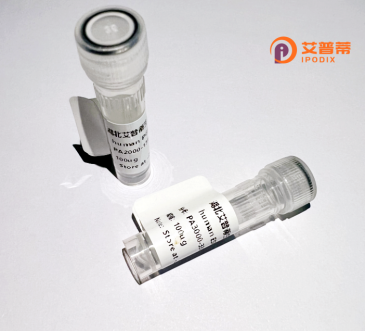
| 纯度 | >90%SDS-PAGE. |
| 种属 | Human |
| 靶点 | SLC38A4 |
| Uniprot No | Q969I6 |
| 内毒素 | < 0.01EU/μg |
| 表达宿主 | E.coli |
| 表达区间 | 1-547 aa |
| 活性数据 | MDPMELRNVNIEPDDESSSGESAPDSYIGIGNSEKAAMSSQFANEDTESQKFLTNGFLGKKKLADYADEHHPGTTSFGMSSFNLSNAIMGSGILGLSYAMANTGIILFIIMLLAVAILSLYSVHLLLKTAKEGGSLIYEKLGEKAFGWPGKIGAFVSITMQNIGAMSSYLFIIKYELPEVIRAFMGLEENTGEWYLNGNYLIIFVSVGIILPLSLLKNLGYLGYTSGFSLTCMVFFVSVVIYKKFQIPCPLPVLDHSVGNLSFNNTLPMHVVMLPNNSESSDVNFMMDYTHRNPAGLDENQAKGSLHDSGVEYEAHSDDKCEPKYFVFNSRTAYAIPILVFAFVCHPEVLPIYSELKDRSRRKMQTVSNISITGMLVMYLLAALFGYLTFYGEVEDELLHAYSKVYTLDIPLLMVRLAVLVAVTLTVPIVLFPIRTSVITLLFPKRPFSWIRHFLIAAVLIALNNVLVILVPTIKYIFGFIGASSATMLIFILPAVFYLKLVKKETFRSPQKVGALIFLVVGIFFMIGSMALIIIDWIYDPPNSKHH |
| 分子量 | 87.2 kDa |
| 蛋白标签 | GST-tag at N-terminal |
| 缓冲液 | PBS, pH7.4, containing 0.01% SKL, 1mM DTT, 5% Trehalose and Proclin300. |
| 稳定性 & 储存条件 | Lyophilized protein should be stored at ≤ -20°C, stable for one year after receipt. Reconstituted protein solution can be stored at 2-8°C for 2-7 days. Aliquots of reconstituted samples are stable at ≤ -20°C for 3 months. |
| 复溶 | Always centrifuge tubes before opening.Do not mix by vortex or pipetting. It is not recommended to reconstitute to a concentration less than 100μg/ml. Dissolve the lyophilized protein in distilled water. Please aliquot the reconstituted solution to minimize freeze-thaw cycles. |
1. 《Functional Characterization of Human SLC38A4 as a Glutamine Transporter》- 作者:Yao et al., 2020
摘要:研究通过重组表达SLC38A4蛋白,验证其作为谷氨酰胺特异性转运体的功能,揭示其在肠上皮细胞氨基酸吸收中的作用。
2. 《SLC38A4 Expression and Regulation in Human Pancreatic Cancer Cells》- 作者:Lee & Chen, 2019
摘要:探讨重组SLC38A4蛋白在胰腺癌细胞中的过表达对肿瘤代谢的影响,发现其通过调控谷氨酰胺摄取促进癌细胞增殖。
3. 《Structural Insights into SLC38A4 Substrate Recognition》- 作者:Müller et al., 2021
摘要:利用冷冻电镜解析重组人SLC38A4蛋白的三维结构,阐明其底物结合域的关键氨基酸残基及转运机制。
4. 《SLC38A4 Deficiency and Neurological Disorders: A Mouse Model Study》- 作者:Harada et al., 2018
摘要:通过重组蛋白功能补偿实验,发现SLC38A4缺失导致小鼠脑部谷氨酰胺代谢异常,可能与神经发育疾病相关。
Solute carrier family 38 member 4 (SLC38A4) is a sodium-coupled amino acid transporter belonging to the SLC38 family, which facilitates the transport of neutral amino acids such as glutamine, alanine, and asparagine across cellular membranes. Primarily expressed in tissues like the liver, placenta, and kidneys, SLC38A4 plays a critical role in maintaining amino acid homeostasis, cellular metabolism, and interorgan nutrient signaling. Its activity is pH-sensitive and energy-dependent, relying on sodium gradients to drive substrate translocation. Structurally, it features multiple transmembrane domains and conserved motifs for substrate recognition and ion coupling.
Recombinant human SLC38A4 protein is engineered through heterologous expression systems (e.g., mammalian or insect cell lines) to study its biochemical properties, substrate specificity, and regulatory mechanisms. This engineered protein enables researchers to explore its physiological roles, including nitrogen metabolism, neurotransmitter precursor supply, and cell proliferation. Dysregulation of SLC38A4 has been implicated in metabolic disorders, cancer progression (e.g., tumor dependency on glutamine), and neurological conditions, making it a potential therapeutic target. Recombinant variants are crucial for high-throughput drug screening, structural analysis (e.g., cryo-EM studies), and functional assays to develop modulators for precision medicine applications. Its study also contributes to understanding nutrient sensing pathways and their links to diseases.
×